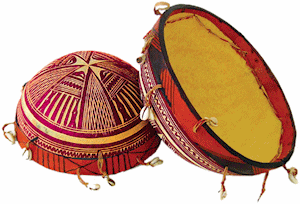Calabash Gourd Uses

The calabash gourd grows on a long vine and is grown for its fruit as well as for use as bottles, bowls, and containers. The calabash gourd is widely known as the bottle gourd although may also be called opo squash, sorakaya, lauki or long melon.
To use the calabash gourd for food it is harvested while it is young, about 10 to 12 inches long, and used as a vegetable. Its flavor is similar to a summer squash and cucumber. The preferred way of preparing the calabash gourd is is to stir fry or boil it. It is a good source of vitamin A, vitamin C, some B vitamins, niacin, thiamine, riboflavin, calcium, potassium, iron, and a good source of fiber.

Decorative calabash bowls can be from AfricaImports.com Calabash gourds are also used to make useful items such as bowls, water and wine bottles, containers, and more. The calabash gourds are allowed to fully mature on the vine. This can take months. Once the gourds are mature, they are cleaned on the outside, cut open and the insides are scraped out. Many times the entire gourd will be sanded and decorated.
Some calabash gourds are used to create musical instruments such as the kora and balafon. They are also used to make women's rattles in Sierra Leone. Some very large calabash gourds are used as percussion intruments. In Nigeria, some motorcyclists wear calabash gourd helmets to get around the motorcycle helmet law.
Interesting Facts:
* The calabash pipe is the choice of stage actors portraying Holmes in Sherlock Holmes plays.
* The design of the Soccer City stadium of South Africa took its inspiration from the shape of calabash. The 2010 FIFA World Cup was played there.
To use the calabash gourd for food it is harvested while it is young, about 10 to 12 inches long, and used as a vegetable. Its flavor is similar to a summer squash and cucumber. The preferred way of preparing the calabash gourd is is to stir fry or boil it. It is a good source of vitamin A, vitamin C, some B vitamins, niacin, thiamine, riboflavin, calcium, potassium, iron, and a good source of fiber.

Some calabash gourds are used to create musical instruments such as the kora and balafon. They are also used to make women's rattles in Sierra Leone. Some very large calabash gourds are used as percussion intruments. In Nigeria, some motorcyclists wear calabash gourd helmets to get around the motorcycle helmet law.
Interesting Facts:
* The calabash pipe is the choice of stage actors portraying Holmes in Sherlock Holmes plays.
* The design of the Soccer City stadium of South Africa took its inspiration from the shape of calabash. The 2010 FIFA World Cup was played there.
This site needs an editor - click to learn more!
You Should Also Read:
What is a Khanga?
Griot - A West African Tradition
African Chew Sticks
Related Articles
Editor's Picks Articles
Top Ten Articles
Previous Features
Site Map
Content copyright © 2023 by Jeanne Egbosiuba Ukwendu. All rights reserved.
This content was written by Jeanne Egbosiuba Ukwendu. If you wish to use this content in any manner, you need written permission. Contact
BellaOnline Administration
for details.


